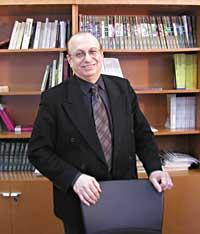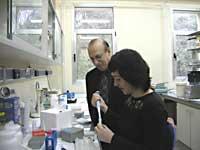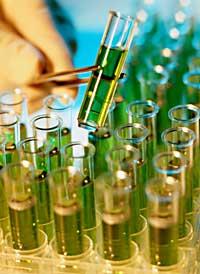Ara Hovanessian touching the AIDS vaccine with her fingers

Thousands of researchers and a single goal: getting an AIDS vaccine. It has been 20 years since they isolated the virus and have not yet gotten the vaccine. It is a difficult task.
An effective vaccine should work on two aspects of the immune system: on the one hand, it should be able to promote the synthesis of anti-HIV cells, T cells. On the other hand, it should help the immune system create antibodies that neutralize the virus.
Researchers have created about 20 vaccines that work in the first part and are already testing with them. However, so far no one has gotten a vaccine that causes antibodies. However, in November 2004 a French group published a hopeful article in Immunity magazine. It seems that they have managed to make the second part necessary to make a good vaccine, that is, they have developed a vaccine that produces antibodies that neutralize the virus.

At the Leioa Campus, the head of research was Ara Hovanessian explaining his work. Researchers have found that by infecting human CD4 T lymphocytes, HIV binds to the cell by a glycoprotein in the skin: glycoprotein gp41. Specifically, it binds to the plasma membrane of the lymphocyte through the CBD-1 part. This allows HIV to attach to the plasma membrane of the lymphocyte and pass through the membrane. Thus it manages to infect the cell.
Researchers have made a synthetic copy of the CDB-1 peptide and injected into rabbits. Then they have seen that synthetic CDB-1 causes antibodies against it in rabbits. These antibodies have been tested on human cell cultures and have been shown to be able to neutralize HIV. They block glycoprotein gp41 so it cannot be associated with the lymphocyte, so it cannot infect the cell. In addition, it eliminates already infected cells, thus avoiding the appearance of new viruses and the infection of other cells.
Several strains of the GIB-1 virus have been tested on crops, all with good results. In fact, the gp41 is the same in all, it does not change. Therefore, the vaccine would be valid for all variants. Moreover, antibodies against CDB-1 in infected humans are very rare, meaning that the vaccine can be used to cure.

The immune response to the synthesized CDB-1 peptide is greater than that produced by the natural, is more immunogenic, making it more effective than the natural. Therefore, they propose to use synthetic CDB-1 as a vaccine: injection to humans would generate antibodies against it, avoiding on the one hand cellular HIV infection and, on the other, the elimination of infected cells.
For use in prophylaxis, they must first test it on monkeys used for human AIDS research and then seek authorization to test it in humans. Therapeutic use will begin to be tested shortly.
It is certainly a breakthrough. However, we will have to wait for the final results to see if expectations are met.
Buletina
Bidali zure helbide elektronikoa eta jaso asteroko buletina zure sarrera-ontzian











